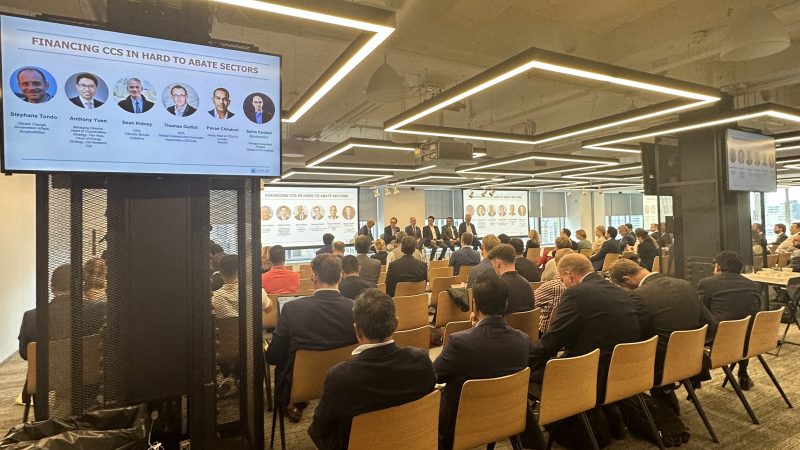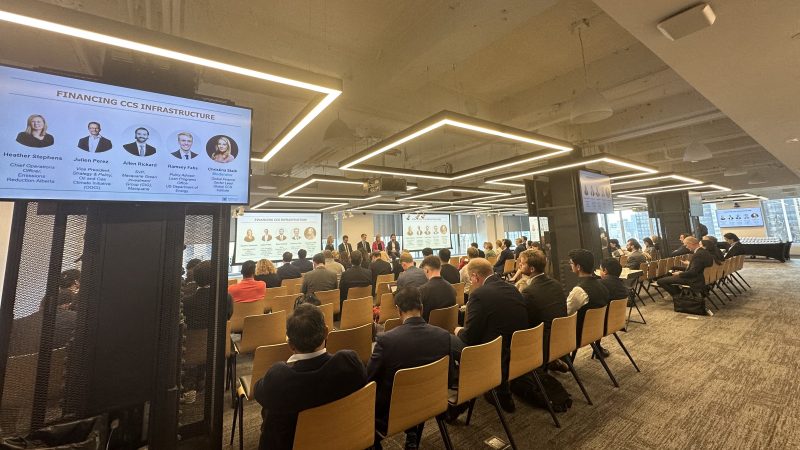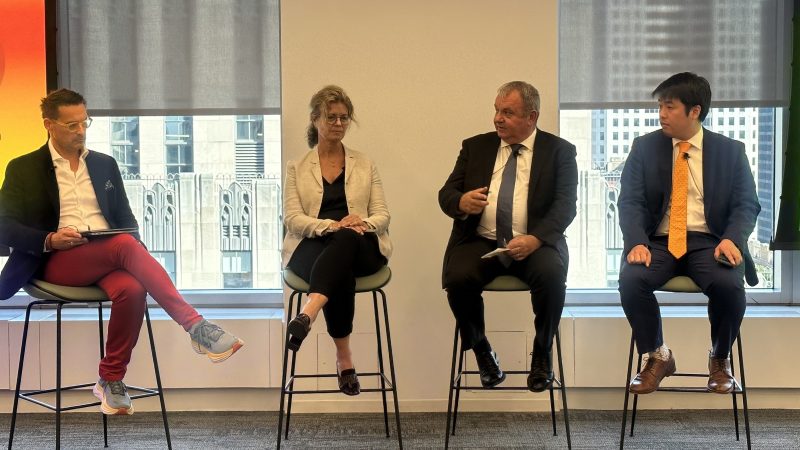Insights and Commentaries
2023 New York Climate Week CCS Finance Event – Recap
Cross-sector insights on potential policy actions and emerging business models that would be conducive to scaling up CCUS deployments
29th September 2023

The Global CCS Institute together with CCUS Initiative of the Clean Energy Ministerial organized on 21 September an event during the New York Climate Week to bring together stakeholders from the finance sector, CCUS project developers and governments to share insights and build collective understanding on possible policy actions and emerging business models that would be conducive to scaling up CCUS deployments.
Latham and Watkins Law firm kindly offered its offices in downtown New York to host the event.
CCUS, including carbon removals through BECCS and DACCS, has been recognized as a crucial climate mitigation technology that plays an important role in achieving climate neutrality. Capital investment of around 1 trillion will be needed globally over the next 30 years to bring CCUS to the level where it can fulfill its potential as a reliable solution to help the world reach net-zero emissions. To achieve the needed level of deployment, various types of capital need to be invested in CCUS. So far the majority of CCUS projects are financed through corporate finance and governmental support.
The speakers and event participants shared their experiences with CCS project financing and offered thoughts on what additional tools and conditions are needed to mobilise sufficient capital to achieve large scale deployment.
Cynthia Wang, the board director at the Global CCS Institute and Mr. Noah Deich, the Deputy Assistant Secretary for the Office of Carbon Management in the Office of Fossil Energy and Carbon Management (FECM) of the US DoE welcomed the workshop participants on behalf of the GCCSI and CEM CCUS.
They emphasized that things are aligning for CCS and that the necessary conditions for achieving scale and bankability in CCUS are finally here. Noah Deich underlined that the policy framework for CCS in the US is ready and the government continues to think how to develop it further, to support long-term CCS deployment at scale.
The first panel focused on Financing CCS in Hard to Abate Sectors
- ArcelorMittal - Stéphane Tondo, Climate Change, Government Affairs
- Citi – Anthony Yuen, Managing Director, Head of Commodities Strategy, Pan-Asia | Head of Energy Strategy, Citi Research
- Climate Bonds Initiative – Sean Kidney, CEO
- Global Cement and Concrete Associate (GCCA) – Thomas Guillot, CEO
- Holcim - Pavan Chilukuri, Group Head of CCUS & e-fuels
- Moderated by Selim Cevikel, Principal Consultant Finance at the Global

This session discussed the importance of decarbonizing hard-to-abate sectors. Steel and cement sectors together account for approximately 10% of carbon dioxide emissions globally.
There is almost a universal agreement that deployment of CCS in these sectors is needed to achieve set climate targets. Incidentally, the infrastructure needed for the energy transition creates additional demand for cement and steel. Yet, from a cost-of-capture perspective, CCS remains an expensive application. Once the cost of transport and storage is added, the equation becomes more complicated and challenging.
As in any abatement technology, the economic value of CCS depends on the policy and regulation that incentivizes innovation and deployment. The investments that are needed are front-ended and capital-intensive.
This panel provided insights into policy and regulatory frameworks that incentivize the development and commercialization of CCS in the cement and steel industries, identified key challenges and gaps in policy, explored avenues for financing CCS projects through available or potential financial instruments.
The panelists highlighted the following points:
CCS in steel and cement
- There are currently 105 CCS projects in various stages of development in the global cement sector (in 2021 the Global Cement and Concrete Association GCCA committed to develop 10 large-scale projects)
- Despite significant progress, the gap in implementation is still huge compared to the required levels of CCS deployment
- Steel sector unlike cement has several mitigation options, including blue hydrogen and DRI
- CCS projects require energy to run capture plants, this becomes an important cost consideration in some geographies
- CO2 is an unavoidable biproduct of cement production. Any cement company will need to deal with multiple CCS projects in multiple locations.
- CO2 per unit of revenues is the highest in the cement sector
Policy landscape
- Political context is important in deciding on mitigation options
- One of the key challenges of CCS is that investments are needed now, while policy and business cases are still in development
- Current policy incentives are still not enough. Need policies on de-risking (e.g. procurement)
Attractiveness for investors
- Companies can issue green bonds to demonstrate their commitment to clean energy transition. Green bonds = access to capital, they increase investor confidence
- The appetite of investors will depend on locations and regulations: e.g. the situation in the US is clear
- When investors compare CCS with renewable energy projects, for example, CCS is still evolving while wind is a certain thing. Also a 5 year return expected with CCS projects is a long time, investors need more confidence
- Role of regional and multilateral development banks is important and needs to be enhanced
Acceptance of CCS is an important prerequisite
- Need to socialize CCS everywhere, partnerships among gov and private sector can help in this regard
- Need to raise confidence of investors
- Need to build confidence in CCS as mitigation
- Carbon accounting from end to end will be important
- There is still need for a wide acceptance of CCS and CCUS.
The second panel focused on Financing CCS Infrastructure
- Emissions Reduction Alberta – Heather Stephens, Chief Operating Officer
- Macquarie Group – Allen Rickard, SVP, Green Investment Group (GIG)
- Oil and Gas Climate Initiative (OGCI) – Julien Perez, Vice President, Strategy and Policy
- United States Department of Energy Loan Programs Office – Ramsey Fahs, Policy Advisor (Contractor)
- Moderated by Christina Staib, Global Finance Sector Lead – Global CCS Institute

This session discussed the importance of CO2 infrastructure – including CO2 transportation and CO2 storage – and how to build business models to attract investments. This panel explored existing and potential policy enablers for CO2 infrastructure development and approaches for CO2 infrastructure business models.
When the topic is CCS, there is often a focus on capture and the cost of capture technologies. But captured CO2 needs somewhere to go – it needs CO2 infrastructure – a catch-all term that we are using to describe CO2 transportation and storage.
Transportation is commonly by pipeline, but it can also be by ship and other means. So if we want to accelerate CCS deployment, we need CO2 infrastructure in place and in development. Infrastructure projects are typically big and need a lot of capital.
This panel discussed enabling policies, how investors viewing CO2 infrastructure as an investment opportunity, and what business models are attractive.
The panelists shared their experiences regarding US policy support in place, relevant findings of magnitude of CO2 infrastructure needed to meet net zero goals, Alberta policy support including geologic sequestration hub process, EU policy support in place, other global policy signals, as well as Infrastructure investor (high-level) perspective on key geographies.
Panelists noted that policy is the key driver for CCS deployment. The US has done a lot and the government is examining what more it can do. It has been estimated that 100 Mt of CO2 is economic for capture, transport and storage given available policies. In Alberta, Canada, price on CO2 is the main driver. It was introduced in 2007, the current level is 65$ and it will increase. In Europe the Innovation Fund allows for 60% risk sharing with the government. In addition, Net Zero Industry Act, CBAM and Contracts for Difference in select European countries create conducive conditions for CCS.
The following investment considerations and potential risks for investors were discussed:
- In what part of the CCS value chain to invest
- CCS up front capital project costs relative to renewable energy project costs
- Permitting timeline – can be 12 months to 4 years
- How to bring emitters on this journey
- Carbon price uncertainty
- Implementation (work force, how to transition)
Panelists also discussed the role of oil and gas companies and the skill sets needed for CCS project development:
- Large project management
- Mindset
- Technical expertise
- Subsurface knowledge
- Capacity to anticipate risks
As for pipelines, it was noted that education of communities is important in securing support. Safety needs to be addressed through rules and regulations.
The third panel focused on the international initiative Global Carbon Management Challenge that aims to increase global CCS ambition.
- Norwegian Ministry of Petroleum and Energy - Henriette Nesheim, Deputy Director-General
- Societe Generale - Allan Baker, Managing Director, Global Head of Energy Transition
- US Department of Energy - Adam Wong, Senior International Advisor
Moderated by Juho Lipponen, Coordinator, CCUS Initiative, Clean Energy Ministerial
Norway and US DOE government representatives provided an overview of the global initiative – Global Carbon Management Challenge (CMC). In a fireside chat US DOE, Norway and SocGen discussed how a global commitment on CCS through CMC could foster scaling up of CCS deployment and attract needed investments. The CMC gathers countries and supporting stakeholders to jointly support the goal of driving carbon management technologies to Gigatonne-scale by 2030. The discussion stressed the role of international collaboration and commitments, expectations from investors, and the importance of concrete national actions and commitments that must be put in place to implement the Challenge.

In conclusion Ellina Levina of the GCCSI and Juho Lipponen of the CCUS CEM highlighted the following key take away messages from the workshop:
- Things are aligning for CCS on micro and macro levels and key industrial sectors such as cement are embracing CCUS as a key decarbonization lever
- However, for CCS to really take off we need a combination of policies:
- Incentives for emitters, including C price, demand pull (procurement)
- Streamlining storage permitting for infrastructure
- Better coordination along the value chain
- Acceptance of CCS and increased level of confidence needs to be built further
- CCS is one of the key mitigation technologies in a package of available solutions, we need all solutions and not one at the expense of another.
- Engagement with emerging economies must be increased, as carbon management can benefit all countries and discussion has so far centered too much on developed economies
- GCCSI and CCUS CEM will continue to collaborate to assist stakeholders on their CCS journey.
This piece was written by Ellina Levina, Senior Manager, Finance and European Affairs with the Global CCS Institute.